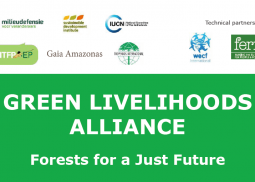
Green Livelihoods Alliance (GLA) 2.0"Forest for a Just Future"
The Green Livelihoods Alliance (2021 – 2025) is an alliance of Gaia Amazonas, IUCN NL, Milieudefensie, NTFP-EP, SDI and Tropenbos International, with Fern and WECF as technical partners.
The Forests for a Just Future program of the Green Livelihoods Alliance (GLA) aims to ensure that tropical forests and forest landscapes are sustainably and inclusively governed to mitigate and adapt to climate change, fulfill human rights and safeguard local livelihoods. In twelve countries in South America, Africa, and Asia, as well internationally, the different alliance members will work with Civil Society Organisations (CSOs), Indigenous People and Local Communities (IPLCs), and social movements to increase the participation of IPLCs in policy and decision-making regarding land rights and forest governance and strengthen lobby and advocacy to hold governments and agro-commodity, extractives, energy and infrastructure industries accountable for deforestation and human rights violations.
GLA aims for gender-just inclusive and sustainable governance of forested landscapes, assuming that this contributes to safeguarding international public goods (clean water, fertile soil, stable climate, and biodiversity).
Our long-term strategic objective is that:
Tropical forests and forest landscapes are sustainably and inclusively governed to mitigate and adapt to climate change, fulfill human rights, and safeguard local livelihoods.
This long-term objective is accompanied by 3 main underlying assumptions:
- Well governed forests provide a large range of services to humans, thereby fulfilling human rights;
- Well governed forests store carbon, sequester carbon dioxide, and provide basic livelihood needs that increase the resilience of IPLCs to the effects of climate change;
- Through improved understanding of their rights, strengthening their organizations for collective action, and engaging with other actors, IPLCs will increase their agency and the likelihood of policies and practices that favour them, reduce land grabs and ensure the long-term maintenance of forest landscapes.
As per the Theory of Change of GLA, there are conditions that should be met at the end of program period:
- Indigenous Peoples and Local Communities (IPLCs) sustainably govern increased areas of forests (Pathway A)
- IPLCs implementing gender inclusive and sustainable forest governance and livelihood strategies (Pathway A)
- Government and agro-commodities, extractives, energy and infrastructure sectors no longer drive deforestation (Pathway B
- Citizens enjoy human and women’s rights and to safely participate in social movements (pathway C).
For more information, please visit the website:
Target Locations



